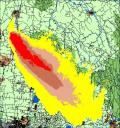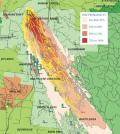This Bushfire CRC project is developing an advanced software program that will help fire managers fight bushfires faster and more effectively, while also identifying communities most at risk from fire. The research team explains the early stages of this research in this video.
Understanding smoke and particulates
Fuel-reduction burning mitigates the risk from bushfires, but the health impacts of the smoke it generates are a major public issue. Balancing the health risks from smoke against the risk to life and property from bushfire, and minimising the risk from prescribed burning, are challenges for agencies charged with meeting large prescribed burning targets.
Before the FireDST project, there was little information about the risk to populations from the transport of smoke from prescribed fires and bushfires or how this impact compared with other risks to health from bushfires.
Dr Mick Meyer at CSIRO, developed a health risk exposure framework for bushfire smoke as part of the FireDST project.
The framework was applied to three contrasting fire events of the past decade: the 2006/2007 Victorian Alpine fire, the Kilmore East fire on Black Saturday (7 February 2009), and a series of high-intensity, prescribed burns in the Huon Valley, Tasmania, in April 2010. The researchers' analysis of the three fire scenarios addressed questions about quantifying the chemical and physical composition of bushfire smoke in smoke plumes.
The study demonstrated that the impact on regional populations from particulate matter (PM) in the smoke could be severe; in the extreme it could be a much greater public health hazard than the direct risks at the fire front. Bushfire emissions of PM can be enormous and fire is often the dominant source of particulate pollution. However, the key issue is not the total emission of PM, but the extent to which it mixes back into the atmosphere’s surface layer and the length of time that PM concentrations remain high around population centres. These are determined by fire duration and the patterns of smoke dispersion. The greatest health impact was from the 2006/2007 Alpine fire, which burned 1.1 million hectares over a period of 60 days. Most of the Victorian population, including Melbourne, was impacted. The model indicates that 84 additional deaths may have occurred due to the health impacts from this fire.
The study also developed procedures for:
• Predicting emissions, transport, surface concentrations and impact from smoke on rural and urban populations.
• Determining the relative importance of potential emission source regions of specified receptor regions.
• Addressing uncertainties in smoke transport due to uncertainties in emission location. This is required for ensemble analysis of risk scenarios.
For some jurisdictions with short prescribed burning seasons, prescribed burning could emulate the scale of large bushfire events with respect to smoke production and its regional impact. Managing these fires to avoid significant health impact will be a growing challenge for managers, who will increasingly rely on smoke dispersion modelling.














